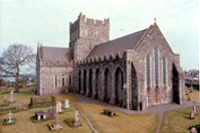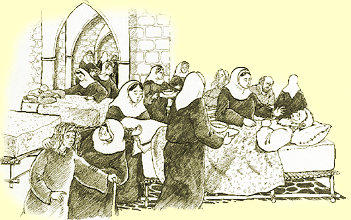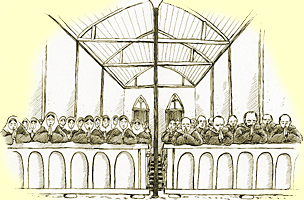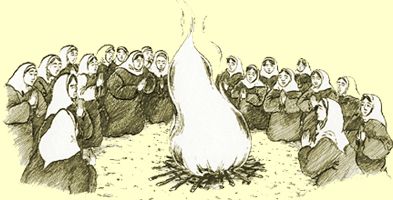| |
| Kildare |
 |
|
The Kildare Cathedral |
|
Cill
Dara, 'The Cell of the Oak': overlooking the plain of
the river Liffey, this double monastery of nuns and monks
is the only one of its kind in Ireland. It is primarily
a convent where monks help out, not a monastery with female
attendants. |
|
|
Kildare was founded in 470 by Saint Brigid,
a formidable personality who impressed rich and poor
alike. The king of Leinster was one of many who had
no hesitation in supporting her cause, and it was he
who made the generous grant of this site, Drom Criadh,
'the ridge of clay'. In its centre stands a giant oak
tree, under which the founder built her cell and oratory,
hence the name, Ceall Dara.
|
| |
read
more |
 |
Saint
Brigid had other foundations around Ireland, prior to
Kildare, but this has been her most lasting legacy. The
quality of mercy lies at the hear of her sisters' work
here, a fact not lost on the sick and the poor, who have
come here in their multitudes over the centuries. |
| A
tradition of unstinting charity and medical care began
here. |
| Looking
at it in the 10th century, Kildare is an impressive sight,
with its cathedral, round tower and high cross, all the
features of a well established and well endowed monastic
city. Of course it wasn't always like this. Like Brigid's
previous foundations, Kildare started life as a collection
of wattle huts surrounded by an earthen wall. Getting
the community going was the priority; monuments could
wait. |
|
That
Kildare grew to such an extent and at such a rate is
testimony to the charisma and energy of its founder.
Everyone looked to Brigid: members of the Church hierarchy
sought her counsel, chieftains came for blessing in
war, and the poor came for comfort and charity in their
frequent hours of need. Kildare very quickly became
a centre of pilgrimage.
|
| |
|
|
With power comes responsibility. So many
people had to be catered for that Brigid applied for
a bishop to be appointed, someone to take charge of
the sisters and pilgrims, someone to hold ecclesiastical
jurisdiction over the surrounding district. Brigid was
allowed to make the choice, and she selected Conleth.
In time, he came to be known as 'Brigid's Brazier' for
his working of gold and silver. With Conleth came the
monks, who provided spiritual ministry for the vast
army of poor and infirm who made their way to Brigid.
|
 |
The
two communities worship daily in the same church at
the same time, but are kept from one another's' eyes
by a high central partition running down the nave, separating
the nuns from the monks. The two communities access
each portion by lateral entrances.
|
| The
cathedral is the only building held in common by the two
autonomous communities for Mass and other services. It
is large and lofty, richly adorned with pictures and hangings,
and ornamental doorways. As the 10th century visitor enters,
he comes into a building that has been rebuilt and refurbished
several times since Brigid's day. The architectural principles
of the first cathedral remain intact, however. |
|
Beyond the cathedral is the round tower,
built in the 9th century to protect the clergy and the
sacred vessels of the cathedral against the raids of
the Danes. One hundred and eight feet high, with five
foot thick walls, it is a very prominent structure.
|
|
Chief
among the treasures to be protected is the Book of Kildare.
Those who have travelled say it compares with the Book
of Kells and the Lindisfarne Gospels. As with all other
religious establishments, the art of copying and illuminating
has been carried out here in Kildare. Indeed, it is
a place of no little industry, with nuns making sacred
vestments, and schools dating back to Brigid.
|
| |
|
 |
And yet for all its riches, perhaps the
most significant feature is St Brigid's Fire-House,
situated between the round tower and the cathedral.
|
Here, a fire is kept continuously burning,
tended by twenty nuns, keeping a light before the Blessed Sacrament.
It honours the relics of the holy foundress, and it welcomes
the poor pilgrims in accordance with the hospitality instituted
by Brigid. Her spirit lives on here.
|
|
|
Related
 |
|
|
|
|
